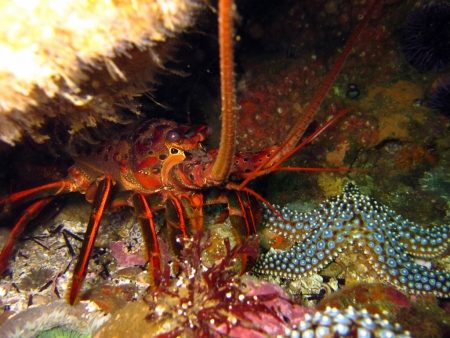Staying Safe This Lobster Season
Sept. 30, 2016 — This Saturday, October 1, marks the opening weekend of the recreational lobster fishing season in California, officially beginning at 12:01 a.m. This is one of the busiest weekends on the water in Southern California, and it’s important that people stay safe and know the rules. So, here’s Heal the Bay’s cheat sheet to the recreational lobster regulations.
On the resource side, the state Department of Fish and Wildlife recently adopted California’s spiny lobster fishery management plan (FMP) to ensure that the fishery is sustainable for both the commercial and recreational sectors, while keeping the Southern California lobster population healthy and thriving. New regulations associated with the FMP won’t take effect until next year’s 2017/2018 lobster season. Heal the Bay participated as the environmental stakeholder on the advisory committee for the management plan.
Spiny lobster play an important role in our kelp forest and rocky reef systems, keeping things balanced by feeding on sea urchins, mussels, and other invertebrates. And, it’s not just people that enjoy rich, sweet taste of lobster, California sheephead, cabezon, horn sharks, and other animals also eat lobster. The good news is that lobster populations are generally doing pretty well in Southern California, especially with the implementation of marine protected areas in 2012.
There has been a commercial fishery in California for spiny lobster since the late 1800s, and now California’s lobster fishery is consistently one of the top five in the state. It is almost entirely based in Southern California. The commercial fishery season typically opens about 5 days after the start of the recreational lobster season.
Because lobster are most active at night, recreational fishing also largely occurs in the dark. Conflicts between boats, divers, and hoop-netters are not uncommon during opening weekend. Here are a few tips to stay safe while lobster fishing, especially during the busy opening weekend:
- Never dive alone. Always dive with a buddy, and keep him or her close. Divers who are dozens of feet apart may not be quick enough to respond in an emergency situation. When free-diving, one buddy should remain on the surface while the other dives in case of a shallow water blackout situation.
- Don’t dive in areas you are unfamiliar with. If you’d like to try a new spot, check it out in the day first to familiarize yourself before heading out at night.
- Watch the weather and ocean conditions. Winds and surge can threaten boats and divers, especially near rocky areas and close to shore.
- If you are setting hoop-nets, be aware of your line. The polypropylene line can get tangled in your boat prop if you are not careful and may disable your boat.
- Keep a back-up flashlight or headlamp aboard your boat. Divers should also carry a back-up dive light.
- As a diver or boater, avoid encroaching on boats that have staked out a spot.
- Inform someone at home of your dive plan or boat plan before you head out on the water.
- When driving your boat at night, watch the water closely for lights and bubbles from submerged divers and avoid those areas. If you end up too close to divers, put your boat into neutral until you pass them to avoid an unsafe encounter.
And, here’s a recap of the CA Department of Fish and Wildlife’s (CDFW) recreational lobster fishing regulations. Check the DFW website or sport-fishing guide for detailed regulations:
- All recreational lobster fishermen 16 years old and older must have a valid sport fishing license.
- All recreational lobster fishermen (regardless of age) must have a spiny lobster report card in their possession while fishing for lobster or assisting in fishing for lobster. Report cards must be reported online at wildlife.ca.gov/reportcards by April 30, following the close of lobster season.
- A $21.60 non-return fee will be charged when purchasing a spiny lobster report card if the previous year’s report card is not returned or reported by the April 30 deadline. To avoid the fee, you may either return or report your card by the deadline, or skip one lobster fishing season. After skipping one season, you can purchase a spiny lobster report card the following season at no extra cost.
- The recreational catch limit is seven lobster, and no more than one daily bag limit of seven can be taken or possessed at any time. (You cannot have more than seven lobster per angler at home at any given time).
- Minimum size limit is 3.25 inch carapace length (measuring from the rear of the eye socket between the horns to the back of the body shell, or carapace). You must carry a lobster gauge to accurately measure catch. All undersize lobster must be released immediately after measurement.
- Do not tail your lobster. Separating the tail from the head makes it impossible to determine whether the lobster is legal size or not, so the lobster must be landed whole.
- Open lobster recreation season runs from the Saturday before the first Wednesday in October, through the first Wednesday after March 15. The 2016-2017 season runs from October 1, 2016 – March 22, 2017.
- Lobster can only be taken by hand or hoop net, and recreational fishermen are limited to no more than five hoop nets/person and vessels may not carry more than 10 hoop nets. When fishing from land, fishermen are limited to two hoop nets.
- Interference with commercial traps or recreational hoop nets is prohibited.
Both commercial and recreational fishing are part of California’s coastal culture. And, charismatic lobster are also a favorite species to spot for non-consumptive divers, making great photo subjects as well. Be safe and have fun this lobster season!
More information is available on the Department of Fish and Wildlife website and through this tip-card.

Spiny lobsters are most active night, posing some challenges for divers.



